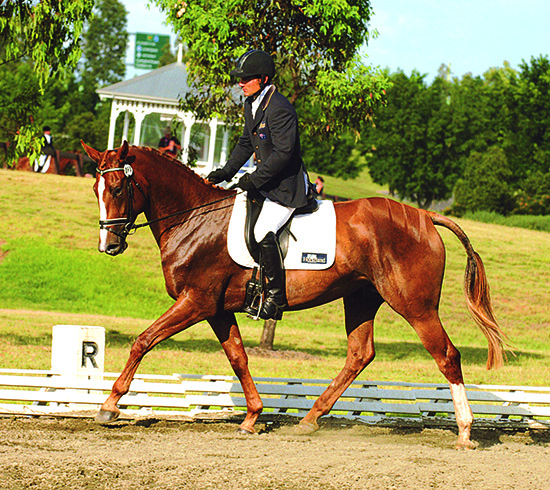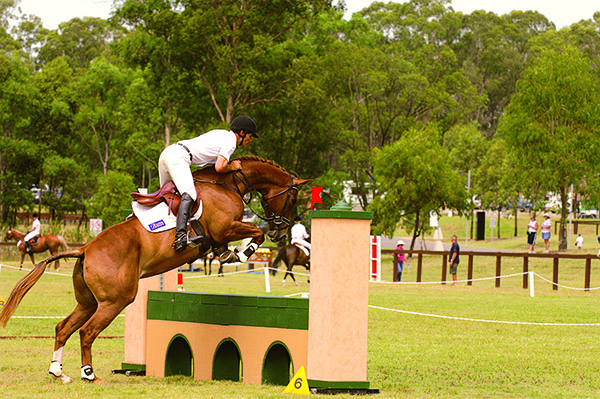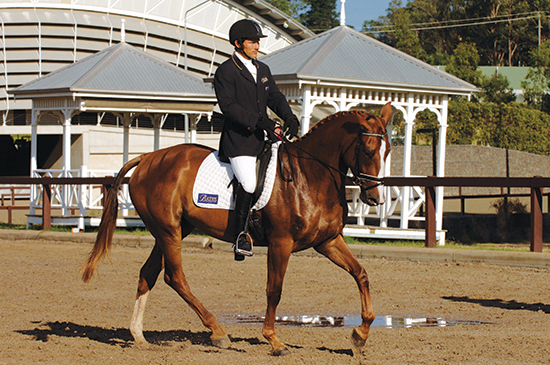 Al-Landra takes the next step.
Al-Landra takes the next step.
Over the last couple of issues we’ve followed the training progress of Shane Rose’s four year old mare Al-Landra. Now ‘Meggsie’ is ready to go to her first one day event at Sydney International Equestrian Centre.
Shane thought her dressage showed that Meggsie had been in work just a bit too long for such a baby:
“She’s had enough now. It would have been good if this week was last week and she was on holidays now. I didn’t really want to get there, but she has got to the stage where she is starting to engage, and it is a bit too soon. As soon as she starts to engage, she finds it difficult, and then she is backing away from it and she is not going forward. She is showing a little tension at times, she goes to engage – especially in the canter on the right leg where she is a bit weaker – and she goes to step through, finds it really difficult, and gets really short and quick. I’m trying to stay slow with a big stride, and she is getting a bit stressed about it.”
“So what do I think about her dressage test? She went into the arena, it wasn’t a nice test, but at least she wasn’t overly worried about the atmosphere of being in the arena. She walked through her walk reasonably well. The things she did wrong were because she isn’t schooled enough, not because she is behaving badly. She ran through a lot of her transitions and corners. She fell out to the right a bit. Perhaps she was a little tired, I did a little more in the warm up than I wanted.”
“Generally I was reasonably happy. We stayed in the arena, we didn’t come last.”
How are you going to work on the contact issue – she has the tendency at the moment to flip out on you?
“It’s related to not being engaged enough. When she actually comes – in inverted commas – ‘on the bit’ and she reaches into the contact, that will go. I didn’t want to get to that stage with her because it is something you have to work them through until they become strong. Once they become strong enough then they can carry the frame, whereas, with her so green and inexperienced, when she goes to get engaged and meets the contact and finds it difficult, that is where she reacts violently and tries to avoid the contact by throwing her head and stepping shorter. It would have been nice if I had let her just pretend to be on the bit, and carry a bit of a shape, and just trot around.”
“I guess when I bring her into work next time round, I can give her a couple of weeks, then start to engage her and as she starts to engage and meet the contact and accept the contact and go forward into it – then hopefully the contact will become more consistent and she will be a little more into the bridle, rather than off it and against it. She is not meeting the contact and accepting it and stepping through, she meets it and stops, and then finds it a little hard on the mouth – and throws her head. That will just come with time and engaging, from riding her forward to the bit and into the bit.”
At the end of all that Meggsie scored a 60.8% to be 14th out of the 32 starters in the Preliminary.
The showjumping however was a little more successful:
“She jumped reasonably well. She had one fence that she touched. I was just a little deep from the turn – she jumped quite big over the previous fence, and was running down. She probably needed a little more leg. The course was a bit smaller than what she has jumped, I think she was a bit tired after the dressage in the morning, but I was reasonably happy with it. When she was a little deep to the square oxer, she actually jumped a nice fence. If she doesn’t jump well, that’s the biggest problem for me because if she makes a mistake, that’s where I can fall down on the ground and hurt myself – so I guess I’ve concentrated on her jumping. That shows, she probably looked as confident with her jumping as any of the horses – whereas on the flat she is probably still a way behind.”
“That’s the way I train my horses up until they go Novice. I’m more interested in the jumping side of it because that is the part that hurts if you get it wrong. If they throw their head in the dressage, then unless you are leaning forward, you are not going to get hurt. I would rather get my horses out jumping confidently and let the dressage come. It takes a horse a few years to get confident and strong enough on the flat, to be able to do that big flashy test and by that stage, hopefully, they are novice / intermediate, and heading to Advanced, and that’s where – hopefully – they come together.”
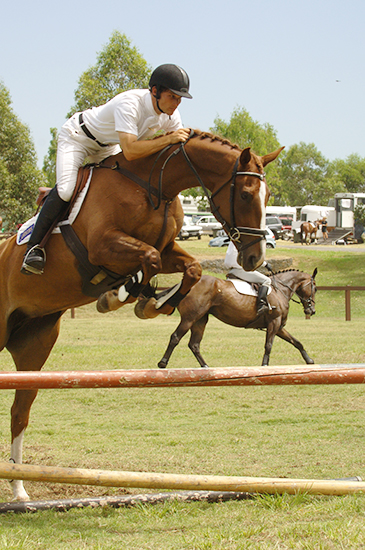 “The way I ride, my horses are more competitive once they go Novice and above – I don’t often win the lower classes, because I am in a rush and I want to get them out there, and jumping jumps. It’s more fun. Dressage to me is not the most entertaining thing unless you are doing exciting stuff – so I probably don’t spend as much time doing dressage with the younger ones, as I do with the more experienced horses.”
“The way I ride, my horses are more competitive once they go Novice and above – I don’t often win the lower classes, because I am in a rush and I want to get them out there, and jumping jumps. It’s more fun. Dressage to me is not the most entertaining thing unless you are doing exciting stuff – so I probably don’t spend as much time doing dressage with the younger ones, as I do with the more experienced horses.”
Despite a run out and 3.2 time, Shane was happy enough with his baby after the cross country:
“She was quite good. I had a run out, at a narrow steeple chase type fence. I don’t normally make excuses, but I was cantering towards the fence and about 50 metres away from it, and a horse just to the left of us was cantering through the water, and Meggsie was looking back to see what the noise was, I was only two strides from the fence when she looked back at the fence, and just ran off to the side.”
“I came round and trotted over it, and she was fine. Everywhere else she was really quite good. She was a little hesitant at both water jumps but not hesitant enough to want to stop, just cautious.”
“Both of the water jumps, you canter down towards them, so she could see what was in front of her, she cantered down fine, didn’t back off too much – she kept trotting or cantering to each fence. She jumped some really nice fences out there.”
How did she handle stringing so many fences together one after another?
“She was fine, she just cantered between the fences, saw a jump in front of her, and just cantered up and jumped it. There is a gully fence where you jump a log, a couple of strides down and back up over the log, she just cantered down, jumped, made a really neat turn after that. She jumped the apex without any spook or trying to go to either side, jumped the middle. Really the only fence she was worried about was the brush she ran out at, and I am not definitely suggesting that she would have jumped it if she hadn’t got a fright but I think she might well have. It wasn’t that she was being dirty or anything like that, she just got a fright, then the fence was a bit close for her to figure out what was going on. It was quite big and quite narrow for a prelim fence, I thought it was tough enough in the pre-novice.”
“I would say that the weekend for her was fairly successful. She jumped a nice showjump round, her cross country although she had 20 penalties was quite good. Her dressage needs improving but I can’t see her jumping holding her back. As soon as she is ready to move on in the dressage, the jumping will come along.”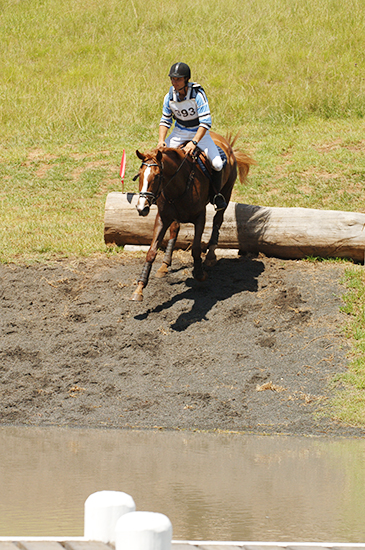
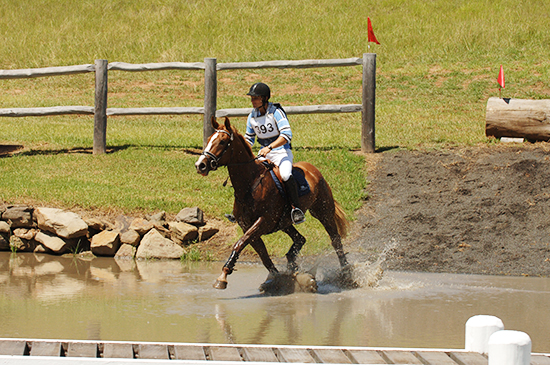
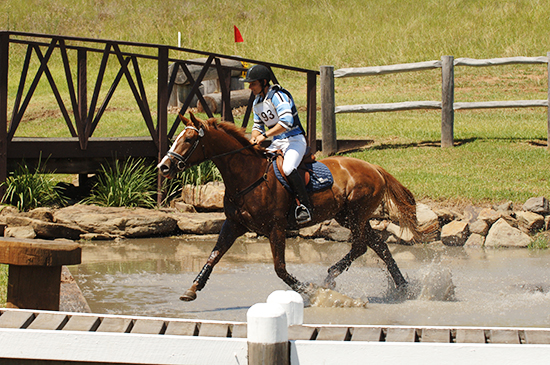
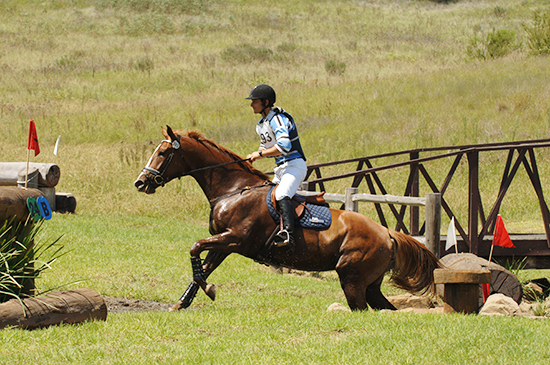 “It’s a nice note to finish this preparation on. She certainly hasn’t had a bad experience this weekend. She didn’t get a fright cross country, showjumping was probably a bit smaller than what she has been used to. The dressage, well she got to go out and see everything and try to concentrate on dressage – which she struggled with at times. I’ll probably give her about six weeks off.”
“It’s a nice note to finish this preparation on. She certainly hasn’t had a bad experience this weekend. She didn’t get a fright cross country, showjumping was probably a bit smaller than what she has been used to. The dressage, well she got to go out and see everything and try to concentrate on dressage – which she struggled with at times. I’ll probably give her about six weeks off.”
Total rest?
“Six weeks of holiday. She’ll go out in a paddock tonight, I won’t ride her, put her on the walker, or exercise her, for six weeks.”
You don’t feel that a break like that means you lose whatever muscling and conditioning you’ve put on?
“No – after about six weeks they will start of lose muscle if they don’t naturally exercise themselves. She’s quite young and she does canter around the paddock a lot, anyway. I’ll give her a break, and then bring her in and give her another couple of months work.”
Do you back off on their feed when they are having a holiday in the paddock?
“No, we don’t. We feed them the same. We feed oats and HiGain Microspeed to our performance horses. All my performance horses get HiGain. Some of Niki’s don’t get the oats, they just get the Microspeed but I feed everything oats and Microspeed and they get that in the paddock, and touch wood, I’ve never had a horse tie up in my life, and I’ve fed grain all my life. I think if you give them the appropriate amount of work for the feed, and if you bring them in to work in a progressive manner, you shouldn’t have problems with horses tying up.”
Can you tell now how far this horse can go – is she a four star horse?
“There are only two things that could hold her back. Whether she is good enough on the flat – and that can change as they get stronger. Some horses get better on the flat, and some just don’t. I think we’ll find out in the next six months if she is going to progress with her dressage. The only other limiting factor is whether she can gallop well enough. Again, time will tell. Her jumping is fine, there’s no problem with her ability to focus on a fence or scope… we’ll see, but right now I am pretty happy with Meggsie.”
So watch out in the future for Shane Rose and one big orange mare, Al-Landra, and remember that you were in on the beginnings of her career.
This article first appeared in the August 2006 edition of The Horse Magazine

